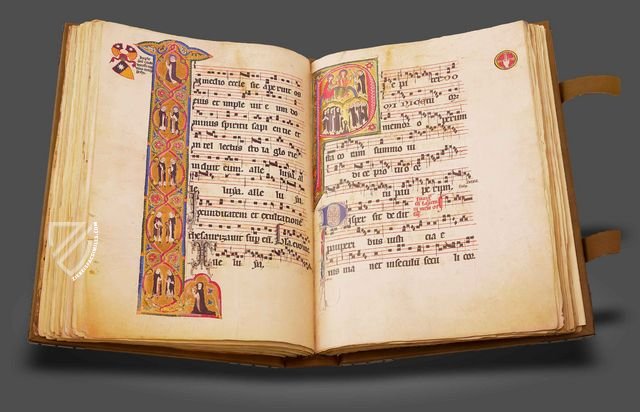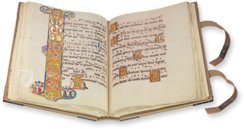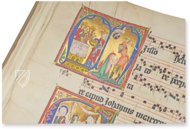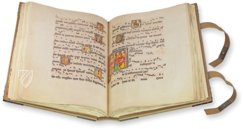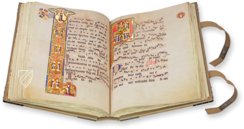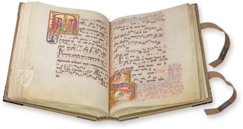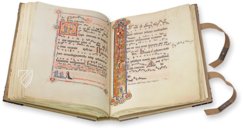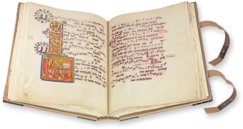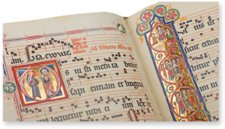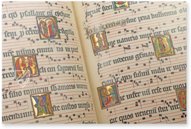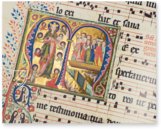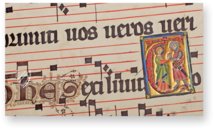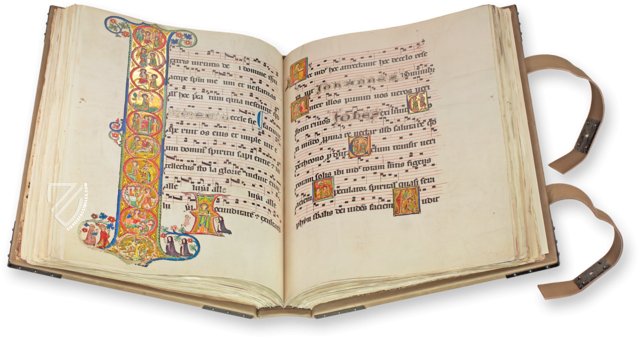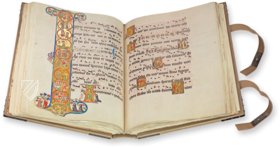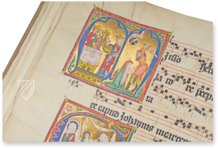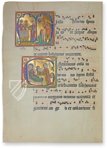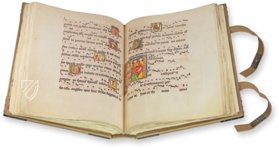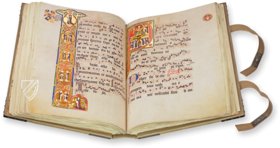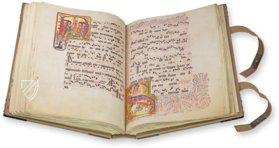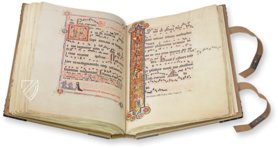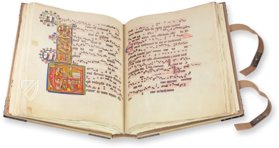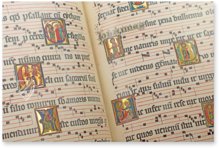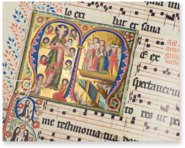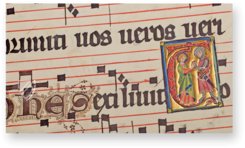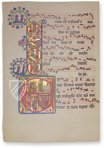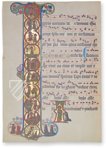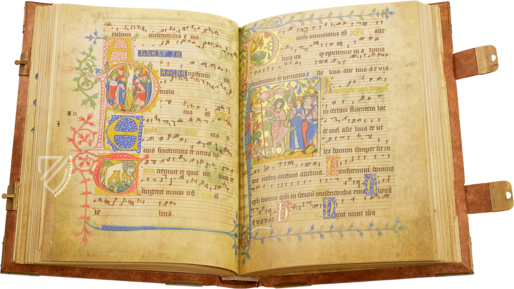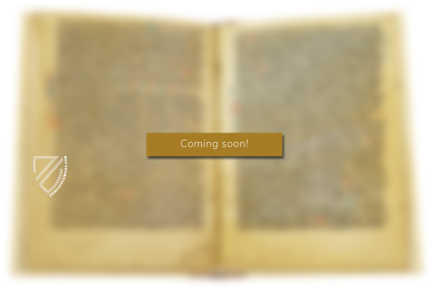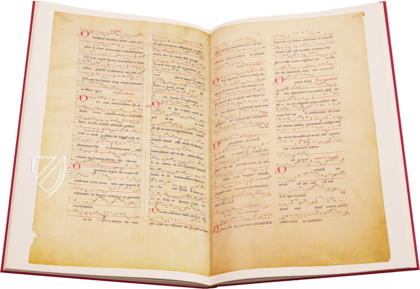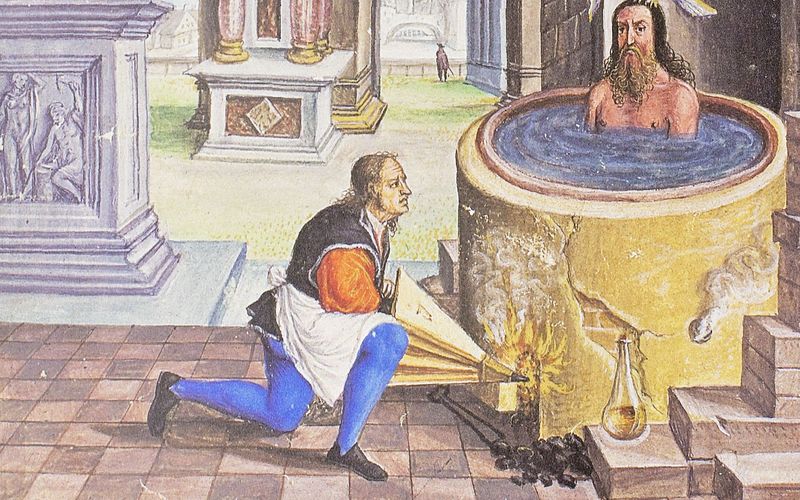Gradual of St. Katharinenthal
(3,000€ - 7,000€)
The Gradual of St. Katherinenthal is a collections of church hymns, which were recited by the Gregorian choir during mass in the 14th century. The sheet music is embellished with brightly colored pictures backed with the finest gold leaf and make the work a top-class performance of Gothic book art.
The Gradual of the St. Katharinenthal Monestary
One of the most preeminent documents of medieval liturgy comes from the St. Katharinenthal monastery in Switzerland, this being the gradual that was composed by the most talented scribes and illuminators of the monastery. A gradual is a collection of Latin hymns that were recited in the 14th century by the Dominican orders and Gregorian choirs in the ceremonial liturgies of the church calendar. The work, which has a very large format of 48 x 35 centimeters, contains 628 pages of sheet music and Latin lyrics. The unusual size is meant to allow all the singers of the choir, even those standing father away, to easily read the pages. The book opens with two pages that contain calendric information. The following pages contain musical scores in the Gregorian four line system, that each incorporate staves and lines of text. The outstandingly expensive decoration of the book consists of 71 elaborately designed miniatures with gold decoration, 13 magnificent flowers painted to form letters, and a considerable amount of calligraphy.
A Masterpiece of Spirituality
The origin of the Gradual of the St. Katharinenthal and its time of creation, circa 1312, is recorded in handwriting on the inside of the front cover. At least six artists were involved in the creation of the work, nevertheless their names were not recorded here. The refinement of the textual composition and the technical perfection of the paintings imply that there were two unbelievably talented masters, who created, with the support of their no less talented monastic brothers, a top-rate performance and perhaps the greatest achievement of Gothic book art from the area of Lake Constance.
A Globally-Coveted Precious Book
After its completion, the gradual remained in the monastery until the 19th century, where it was used by the monastic choir in Messen. Around 1820, it became the property of a Swiss antiquarian by unknown means, who displayed the book in his museum and separated both of its costliest and most prized miniatures from the work. Both pages exist today, they have however been disassembled and are to be found in the collections of various institutions and private persons. In 1958, the gradual emerged in the estate of the English art collector Sir Charles Perrins, and was auctioned. The Swiss Federal Council reacquired the work in this auction, which was only possible though the financial support of the Gottfried-Keller Foundation and the Canton of Thurgau. Since December 9, 1985, this precious book is once again to be found Switzerland.
An Artistic Feat
The inestimably valuable gradual gained its exceptional fame because of the richness of its illustrations. The 71 miniatures are eminently fine and drawn in brilliant colors. Nearly every one of the illustrations was decorated with gold leaf, begetting the lofty character of the work. With the composition of the paintings, the artists have reflected on the formally quintessential and important biblical events and depicted them in serene clarity. The monumental initials and the countless calligraphic elements are the artistic trademarks of its masters. All in all, the Gradual of St. Katharinenthal is a masterly performance of European Gothic.
Codicology
- Alternative Titles
- Graduale von St. Katharinenthal
- Size / Format
- 628 pages / 48.0 × 35.0 cm
- Origin
- Switzerland
- Date
- 1312
- Epochs
- Style
- Genre
- Language
- Illustrations
- 71 delicately painted miniatures, rich in gold decoration, and 13 ornate initials
- Previous Owners
- Sir Charles Dyson Perrins (1864–1958)
Gradual of St. Katharinenthal
“E“ Initial
This marvelous “E” initial features a burnished gold background and is itself wonderfully patterned with dark red on the outside and pink on the inside. It is divided into two registers with the upper scene depicting a mass. Crowned ladies can be seen kneeling in front of the rest of the laity as they receive a blessing from a bishop. To the right, we can see four-line staves in red ink and neume notation in black ink created according to the Gregorian style.
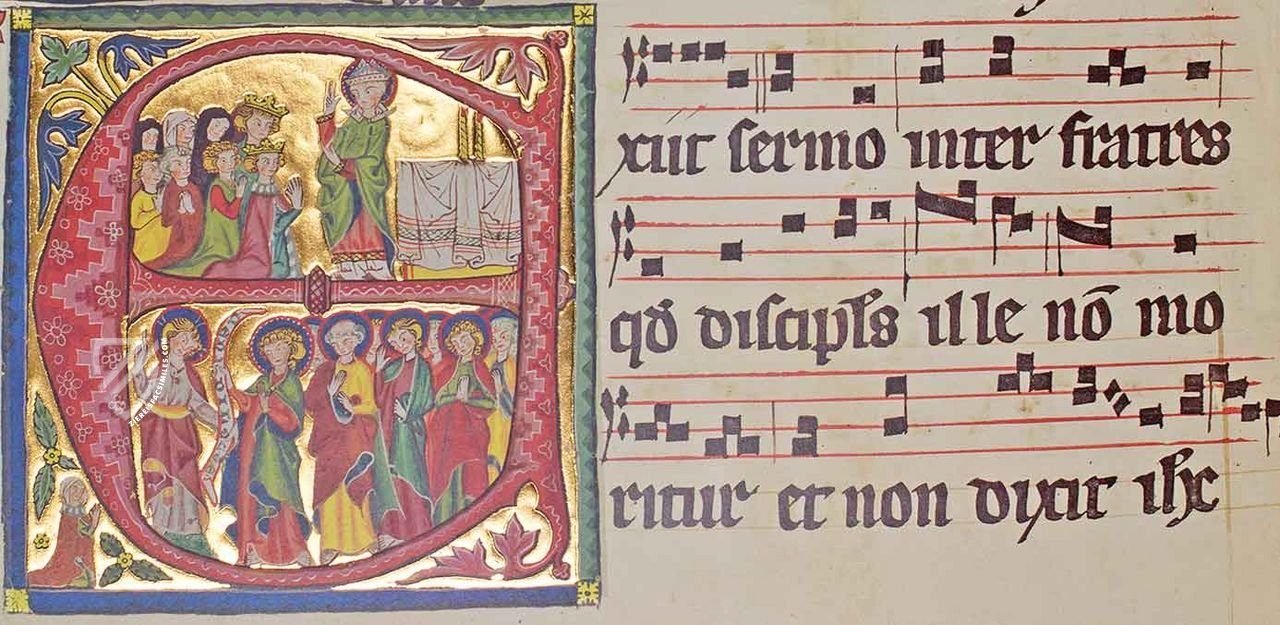
Gradual of St. Katharinenthal
Beheading of John the Baptist / Birth of Mary
These masterful miniatures are presented in large historiated initials. The upper scene portrays the beheading of John the Baptist, while the lower scene presents the birth of the Virgin Mary. Both are backed by burnished gold, brightly colored, and contained within patterned letters – “M” and “C” respectively.
The upper miniature shows the moment of John’s martyrdom: the executioner is on his tip toes, his sword dripping with blood, but the hand of God simultaneously reaches down to bless him, and the presentation of his head is shown to the right. The lower miniature is distinguished by its detail, e.g. the letter is not only decorated with an intricate red and blue pattern, but its tips grow into leaves of yellow, green, and red.
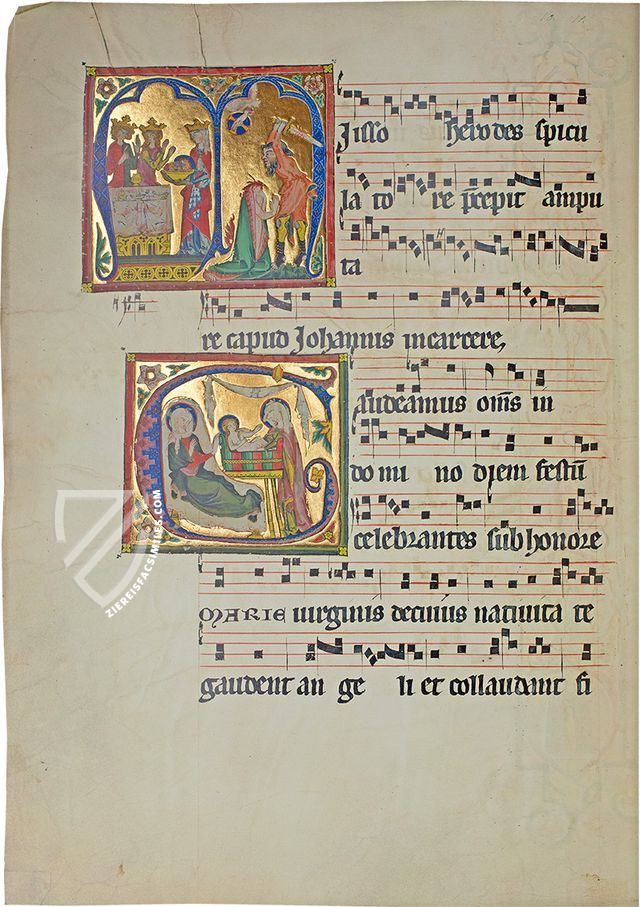
#1 Graduale von St. Katharinenthal
Language: German
(3,000€ - 7,000€)
- Treatises / Secular Books
- Apocalypses / Beatus
- Astronomy / Astrology
- Bestiaries
- Bibles / Gospels
- Chronicles / History / Law
- Geography / Maps
- Saints' Lives
- Islam / Oriental
- Judaism / Hebrew
- Single Leaf Collections
- Leonardo da Vinci
- Literature / Poetry
- Liturgical Manuscripts
- Medicine / Botany / Alchemy
- Music
- Mythology / Prophecies
- Psalters
- Other Religious Books
- Games / Hunting
- Private Devotion Books
- Other Genres
- Afghanistan
- Armenia
- Austria
- Belgium
- Belize
- Bosnia and Herzegovina
- China
- Colombia
- Costa Rica
- Croatia
- Cyprus
- Czech Republic
- Denmark
- Egypt
- El Salvador
- Ethiopia
- France
- Germany
- Greece
- Guatemala
- Honduras
- Hungary
- India
- Iran
- Iraq
- Israel
- Italy
- Japan
- Jordan
- Kazakhstan
- Kyrgyzstan
- Lebanon
- Liechtenstein
- Luxembourg
- Mexico
- Morocco
- Netherlands
- Palestine
- Panama
- Peru
- Poland
- Portugal
- Romania
- Russia
- Serbia
- Spain
- Sri Lanka
- Sweden
- Switzerland
- Syria
- Tajikistan
- Turkey
- Turkmenistan
- Ukraine
- United Kingdom
- United States
- Uzbekistan
- Vatican City
- A. Oosthoek, van Holkema & Warendorf
- Aboca Museum
- Ajuntament de Valencia
- Akademie Verlag
- Akademische Druck- u. Verlagsanstalt (ADEVA)
- Aldo Ausilio Editore - Bottega d’Erasmo
- Alecto Historical Editions
- Alkuin Verlag
- Almqvist & Wiksell
- Amilcare Pizzi
- Andreas & Andreas Verlagsbuchhandlung
- Archa 90
- Archiv Verlag
- Archivi Edizioni
- Arnold Verlag
- ARS
- Ars Magna
- ArtCodex
- AyN Ediciones
- Azimuth Editions
- Badenia Verlag
- Bärenreiter-Verlag
- Belser Verlag
- Belser Verlag / WK Wertkontor
- Benziger Verlag
- Bernardinum Wydawnictwo
- BiblioGemma
- Biblioteca Apostolica Vaticana (Vaticanstadt, Vaticanstadt)
- Bibliotheca Palatina Faksimile Verlag
- Bibliotheca Rara
- Boydell & Brewer
- Bramante Edizioni
- Bredius Genootschap
- Brepols Publishers
- British Library
- C. Weckesser
- Caixa Catalunya
- Canesi
- CAPSA, Ars Scriptoria
- Caratzas Brothers, Publishers
- Carus Verlag
- Casamassima Libri
- Centrum Cartographie Verlag GmbH
- Chavane Verlag
- Christian Brandstätter Verlag
- Circulo Cientifico
- Club Bibliófilo Versol
- Club du Livre
- CM Editores
- Collegium Graphicum
- Collezione Apocrifa Da Vinci
- Comissão Nacional para as Comemorações dos Descobrimentos Portugueses
- Coron Verlag
- Corvina
- CTHS
- D. S. Brewer
- Damon
- De Agostini/UTET
- De Nederlandsche Boekhandel
- De Schutter
- Deuschle & Stemmle
- Deutscher Verlag für Kunstwissenschaft
- DIAMM
- Droz
- E. Schreiber Graphische Kunstanstalten
- Ediciones Boreal
- Ediciones Grial
- Ediclube
- Edições Inapa
- Edilan
- Editalia
- Edition Deuschle
- Edition Georg Popp
- Edition Leipzig
- Edition Libri Illustri
- Editiones Reales Sitios S. L.
- Éditions de l'Oiseau Lyre
- Editions Medicina Rara
- Editorial Casariego
- Editorial Mintzoa
- Editrice Antenore
- Editrice Velar
- Edizioni Edison
- Egeria, S.L.
- Eikon Editores
- Electa
- Emery Walker Limited
- Enciclopèdia Catalana
- Eos-Verlag
- Ephesus Publishing
- Ernst Battenberg
- Eugrammia Press
- Extraordinary Editions
- Fackelverlag
- Facsimila Art & Edition
- Facsimile Editions Ltd.
- Facsimilia Art & Edition Ebert KG
- Faksimile Verlag
- Feuermann Verlag
- Folger Shakespeare Library
- Franco Cosimo Panini Editore
- Friedrich Wittig Verlag
- Fundación Hullera Vasco-Leonesa
- G. Braziller
- Gabriele Mazzotta Editore
- Gebr. Mann Verlag
- Gesellschaft für graphische Industrie
- Getty Research Institute
- Giovanni Domenico de Rossi
- Giunti Editore
- Graffiti
- Grafica European Center of Fine Arts
- Guido Pressler
- Guillermo Blazquez
- Gustav Kiepenheuer
- H. N. Abrams
- Harrassowitz
- Harvard University Press
- Helikon
- Hendrickson Publishers
- Henning Oppermann
- Herder Verlag
- Hes & De Graaf Publishers
- Hoepli
- Holbein-Verlag
- Houghton Library
- Hugo Schmidt Verlag
- Idion Verlag
- Il Bulino, edizioni d'arte
- ILte
- Imago
- Insel Verlag
- Insel-Verlag Anton Kippenberger
- Instituto de Estudios Altoaragoneses
- Instituto Nacional de Antropología e Historia
- Introligatornia Budnik Jerzy
- Istituto dell'Enciclopedia Italiana - Treccani
- Istituto Ellenico di Studi Bizantini e Postbizantini
- Istituto Geografico De Agostini
- Istituto Poligrafico e Zecca dello Stato
- Italarte Art Establishments
- Jan Thorbecke Verlag
- Johnson Reprint Corporation
- Josef Stocker
- Josef Stocker-Schmid
- Jugoslavija
- Karl W. Hiersemann
- Kasper Straube
- Kaydeda Ediciones
- Kindler Verlag / Coron Verlag
- Kodansha International Ltd.
- Konrad Kölbl Verlag
- Kurt Wolff Verlag
- La Liberia dello Stato
- La Linea Editrice
- La Meta Editore
- Lambert Schneider
- Landeskreditbank Baden-Württemberg
- Leo S. Olschki
- Les Incunables
- Liber Artis
- Library of Congress
- Libreria Musicale Italiana
- Lichtdruck
- Lito Immagine Editore
- Lumen Artis
- Lund Humphries
- M. Moleiro Editor
- Maison des Sciences de l'homme et de la société de Poitiers
- Manuscriptum
- Martinus Nijhoff
- Maruzen-Yushodo Co. Ltd.
- MASA
- Massada Publishers
- McGraw-Hill
- Metropolitan Museum of Art
- Militos
- Millennium Liber
- Müller & Schindler
- Nahar - Stavit
- Nahar and Steimatzky
- National Library of Wales
- Neri Pozza
- Nova Charta
- Oceanum Verlag
- Odeon
- Orbis Mediaevalis
- Orbis Pictus
- Österreichische Staatsdruckerei
- Oxford University Press
- Pageant Books
- Parzellers Buchverlag
- Patrimonio Ediciones
- Pattloch Verlag
- PIAF
- Pieper Verlag
- Plon-Nourrit et cie
- Poligrafiche Bolis
- Presses Universitaires de Strasbourg
- Prestel Verlag
- Princeton University Press
- Prisma Verlag
- Priuli & Verlucca, editori
- Pro Sport Verlag
- Propyläen Verlag
- Pytheas Books
- Quaternio Verlag Luzern
- Reales Sitios
- Recht-Verlag
- Reichert Verlag
- Reichsdruckerei
- Reprint Verlag
- Riehn & Reusch
- Roberto Vattori Editore
- Rosenkilde and Bagger
- Roxburghe Club
- Salerno Editrice
- Saltellus Press
- Sandoz
- Sarajevo Svjetlost
- Schöck ArtPrint Kft.
- Schulsinger Brothers
- Scolar Press
- Scrinium
- Scripta Maneant
- Scriptorium
- Shazar
- Siloé, arte y bibliofilia
- SISMEL - Edizioni del Galluzzo
- Sociedad Mexicana de Antropología
- Société des Bibliophiles & Iconophiles de Belgique
- Soncin Publishing
- Sorli Ediciones
- Stainer and Bell
- Studer
- Styria Verlag
- Sumptibus Pragopress
- Szegedi Tudomànyegyetem
- Taberna Libraria
- Tarshish Books
- Taschen
- Tempus Libri
- Testimonio Compañía Editorial
- Thames and Hudson
- The Clear Vue Publishing Partnership Limited
- The Facsimile Codex
- The Folio Society
- The Marquess of Normanby
- The Richard III and Yorkist History Trust
- Tip.Le.Co
- TouchArt
- TREC Publishing House
- TRI Publishing Co.
- Trident Editore
- Tuliba Collection
- Typis Regiae Officinae Polygraphicae
- Union Verlag Berlin
- Universidad de Granada
- University of California Press
- University of Chicago Press
- Urs Graf
- Vallecchi
- Van Wijnen
- VCH, Acta Humaniora
- VDI Verlag
- VEB Deutscher Verlag für Musik
- Verlag Anton Pustet / Andreas Verlag
- Verlag Bibliophile Drucke Josef Stocker
- Verlag der Münchner Drucke
- Verlag für Regionalgeschichte
- Verlag Styria
- Vicent Garcia Editores
- W. Turnowski Ltd.
- W. Turnowsky
- Waanders Printers
- Wiener Mechitharisten-Congregation (Wien, Österreich)
- Wissenschaftliche Buchgesellschaft
- Wissenschaftliche Verlagsgesellschaft
- Wydawnictwo Dolnoslaskie
- Xuntanza Editorial
- Zakład Narodowy
- Zollikofer AG

